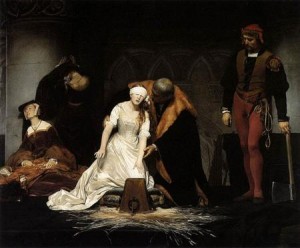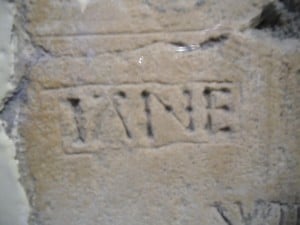 On this day in history, 12th February 1554, Lady Jane Grey and her husband, Guildford Dudley, were beheaded in London; Guildford on Tower Hill and Jane within the walls of the Tower of London.
On this day in history, 12th February 1554, Lady Jane Grey and her husband, Guildford Dudley, were beheaded in London; Guildford on Tower Hill and Jane within the walls of the Tower of London.
Chronicler and printer Richard Grafton recorded their executions (tip: ‘v’s and ‘u’s are interchangeable in primary sources like this):
“The. xij. day of February next folowyng the Lady Jane of Suffolke and the Lorde Guylforde her husband who before (as you haue heard) were attaynted of Treason, the one for the vsurpation of the estate royall as Queene, the other as a principall adherent to her in that case, according to the iadgement geuen agaynst them suffered execution of death, that is to wyt, he at the Tower hill vpon the Scaffolde, and shee within the Tower, whose deaths were y rather hastened, for that the Duke of Suffolk father to this Ladie, had of late (as ye haue heard) revved a newe sturre and commotion in his Countrie, making proclamation in the name of his daughter as Queene, which was the shortening of herlife, who else was lyke ynough to haue bene pardoned. This gentle yong Ladie endued with singuler gifts both of learning and knowledge as pacyent and mylde as any Lambe came to the place of her execution. And a little before her death beyng vpon the Scaffolde vttered these wordes.
Good people I am come hether to ‘die, and by a law I am condempned to the same. My offence agaynst the Queenes highnesse was onely in consent to the deuise of other, which now is deemed Treason, but it was neuer of my seeking, but by counsayle of those who should seeme to haue further vnderstanding of thinges then I, which knewe little of the lawe, and much lesse of titles to the crowne : But touching the procurement and desire therof by me or on my behalfe, I doe washe my handes in innocency therof before God, and the face of all you (good christian people) this day, and therewith she wrong her handes, wherein she had her booke. Then savde shee I pray you all good christian people, to beare me wytnesse, that I die a true christian woman, & that I looke to be saued by none other meanes, but only by the mercie of God in the bloud of his onely sonne Iesus Christ. And I confesse that when I did knowe the worde of God, I neglected the same, and loued my selfe and the worlde, and therfore this plague and punishment is iustly and worthily happened vnto mee for my sinnes. And yet I thanke God of his goodnesse that he hath geuen mee a tyme and respite to repent. And nowe good people while I am a live, I praye you assist me with your prayers.
And then kneeling downe she said the Psalme of (Miserere mei deus) in English, and then stood vp and gaue her mavden (called mystresse Eleyn) her Gloues and Handkerchefe, and her booke shee gaue to mayster Bruges then Lieutenaunt of the Tower, and so vntyed her Gowne, and the executioner pressed to helpe her of with it, but she desired him to let her alone, and turned her towardes her two Gentlewomen, who helped her of therwith, & with her other attyres, and they gaue her a fayre Handkerchefe to put about her eyes. Then the executioner kneeled downe and asked her forgeuenesse: whome she forgaue most wyllingly. Then he wylled her to stande vpon the strawe, which done shee sawe the block, and then she sayde I praye you dispatche me quickly. Then she kneeled downe saiyng, will you take it of before I laye me downe? wherevnto the executioner aunswered, no Madame, then tyed she the Handkerchefe about her eyes, and feeling for the block she sayd, where is it, where is it? One of the standers by guyded her therevnto, and shee layde downc her head vpon the block, and then stretched foorth her bodie, and sayde. Lorde into thy hands I commend my spirite, and so finished her life in the yere of our Lorde. 1553. the. xij. day of Februarie.”
Guildford was actually executed first:
“The same daye a litle before this young Ladyes execution, the Lorde Guilforde her housbande who was a very comely tall Gentlemen, was executed on the Skaffolde at the Tower hill, as aforesayd, whose dead Carkas liyng in a Carre in strawe, was againe brought into the Tower, at the same instant that the Ladie Jane his wife went to her death within the Tower, which miserable sight was to her a double sorow & griefe. Thus these two simple yong soules suffered ignorantly for that, which their parentes & other had vnhappily brought about to the vtter subuersio of them & their famelies.”
How awful that Jane encountered her husband’s dead body as she was led out of the Tower to her death.
The couple’s remains were buried in the Chapel of St Peter ad Vincula, in the Tower grounds.
The carving below can be found in the upper chamber of the Tower of London’s Beauchamp Tower and is traditionally thought to have been made by one of the Dudley family. It says “IANE” (JANE).

Sources
- Grafton’s chronicle: or, History of England. To which is added his table of the bailiffs, sherrifs, and mayors, of the city of London. From the year 1189 to 1558, inclusive, Volume 2, Richard Grafton (c. 1511–1572), 1809 edition, p543-544 – This can be read online at Archive.org